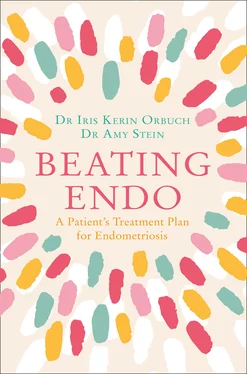Certainly in most of the cases referred to Amy, whatever the cause, the biomechanics of the patient’s pelvic area had been adversely affected. Amy’s treatment of manual therapy, stretching, and strengthening—plus nutritional support and other self-care practices—did mitigate these patients’ pain and bring them relief. But among the women in this particular group, the improvement they realized through physical therapy then leveled off; they simply stopped advancing. The very question that Iris was asking herself hung in the air for Amy as well: Why weren’t these women getting 100 percent better? What was keeping them from advancing past the plateau? Patients would arrive at her office ranking their pain as 8 or 9 on a scale from 1 to 10—where 10 is the worst pain conceivable—and in time, the PT and behavioral changes brought it down to anywhere from 4 to 2. But it seemed that nothing she tried with these patients could eliminate the pain entirely. In her own eyes, Amy wasn’t achieving the complete healing she wanted for them.
She was haunted by the memory of a 2005 meeting in Sydney, Australia, of the International Pelvic Pain Society (IPPS). Dr. Fred Howard, a prominent American gynecologist and a co-founder of IPPS, was giving a presentation to an audience of other gynecologists, urologists, physical therapists like Amy, nurse practitioners, and primary care physicians. The heart of his talk was a deck of slides showing different conditions in the pelvic area. “Raise your hand if you think what you’re looking at is endometriosis,” Dr. Howard instructed his audience. The pictures varied; some looked perfectly bland, some troubled. In all, some 15 to 25 percent of the audience raised their hands at some of the slides, yet all of the slides in fact pictured endometriosis at different stages of progression. It meant that 75 percent to 85 percent of the specialists and practitioners in attendance got it wrong or simply did not recognize what they were looking at. “Endo is being misdiagnosed,” Howard concluded, and he added, “We have to make a change.”
For the attendees at the conference, that presentation also made it clear that endo could only be reliably diagnosed via biopsy. The change Howard was calling for was for the practitioners in the audience to keep endo in mind when coming up against a puzzling condition in female patients—especially if the condition proved intractable and was related to their menstrual history.
Amy had for some time suspected that a number of these patients she was seeing might have endo, especially those patients who were frustrated by the recurrence of their pain, or by the fact that the physical therapy relieved certain symptoms while others persisted. She concentrated on making a concerted effort to raise the endo issue in reaching out to other practitioners. By now, in order to confirm the diagnosis of the condition, she was referring patients almost exclusively to the small handful of gynecologists she was aware of nationwide who seemed to understand endometriosis. At the same time, to address the pain in those patients who had plateaued in their treatment, she referred them on to the equally minuscule number of physiatrists she was aware of at the time—specialists in physical medicine and rehabilitation aimed at restoring function in the case of a disabling or chronic impairment. She kept making connections among these practitioners, introducing herself, via email or in accompanying a patient to a doctor’s appointment, representing herself as a member of the Board of the International Pelvic Pain Society and asking to chat. She wanted to be sure there was a meeting of the minds before she referred patients onward.
TEAMING UP
We think that Iris received one of those emails and replied right back that she was convinced that physical therapy was a “huge missing link” in the whole pelvic pain/endometriosis picture. We think that is what brought Amy into Iris’s office one day to talk about the work she was doing, the results she was seeing, and the limits she came up against. What we both know is that not too long into our conversation, light bulbs lit up in both our brains. Here was a kindred spirit—a practitioner on the same wavelength and asking the same question about far too many women who were not getting better and who very likely, in both our views, suffered from endometriosis.
From Amy’s point of view, Iris was one of perhaps a handful of surgeons throughout the United States who did not think surgery was the immediate go-to solution for the pain and discomfort she witnessed in her endo patients. At last, here was a New York City medical expert—a prominent specialist in endo—who took a holistic approach. From Iris’s point of view, Amy was a practitioner who actually brought pain relief to endo sufferers through PT techniques that managed the biomechanical and tissue dysfunctions, through basic nutrition, and through other forms of self-care—without drugs—and who understood that more was needed.
She gets it! Iris decided. So does she! thought Amy. In a kind of mutual relief, a professional partnership was born.
We had and have a lot in common in our personal and professional lives, but what binds us together absolutely is this shared passion for caring for women with endo. We have seen how the disease can sharply limit the scope of a woman’s capabilities, curb her physical activities, restrict her opportunities for work and school and play, burden her spirit and emotional well-being, blunt the pleasure or satisfaction of daily life with family and friends, and diminish the most physically and mentally robust decades available to her.
Starting in about 2010, we began to mesh our specialties and to expand our portfolio of therapeutic resources. Our aim was first to understand the disease process in greater depth and detail, then to create an effective approach to dealing with it. We constantly talked to each other about what we were seeing and about what worked and what didn’t work to bring relief. And we reached out to practitioners and researchers across the healthcare spectrum, exploring what they were doing that was pertinent. Their input became part and parcel of the integrated approach this book presents, and you will hear directly from a number of them in the pages that follow.
We also will take a closer look at the impact the disease of endometriosis can have on a woman’s life. We’ll note the treatments typically offered by a fragmented medical profession that often sees only through its separate specialties and fails to look at the whole patient, and we will show you why so many of those treatments fail to provide sustained relief.
What we’ll arrive at instead is an integrated multimodal strategy that will equip you with the knowledge you need to begin to beat endo and reclaim your life. By “multimodal” we mean that our protocol comprises different actions; by “integrated” we mean the actions are purposefully linked in an individual “set” or “arrangement” that is right for you. It includes, when needed and at the right time in your treatment process, the excision surgery that is the sole known method for removing endometriosis from the body.
While we are both sympathetic to the contemporary reader’s tendency to jump to the chapter that seems most personally relevant, we urge you to read the chapters of Beating Endo in order. Understanding the full implications of what this disease can do is the first essential for beating it, and that understanding unfolds almost as a narrative. At the same time, we put in your hands the tools to combat every theft of life endo represents, and we show you how, if you use the tools right, you can take back your life from the disease and live it to the fullest.
Читать дальше











